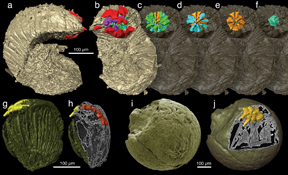|
News Notes
Paleontology
Fossil embryos exposed in 3-D
 For researchers looking to trace the evolutionary histories of life on Earth, good things come in small packages: For the first time, advanced X-ray imaging technology has captured a 3-D look inside tiny fossil embryos, revealing details that confirm one animal’s place on the evolutionary tree.
For researchers looking to trace the evolutionary histories of life on Earth, good things come in small packages: For the first time, advanced X-ray imaging technology has captured a 3-D look inside tiny fossil embryos, revealing details that confirm one animal’s place on the evolutionary tree.
3-D images of Markuelia embryo fossils reveal internal structures, including successive layers of teeth in Markuelia’s mouth (top row), as well as detailed views of its digestive track and anus (bottom row). Researchers used the newly revealed structures to determine Markuelia’s relationship to the modern penis worm. Image is by Philip Donoghue and colleagues.
Markuelia, a worm-like animal that lived more than 500 million years ago during the Cambrian, appears to be a distant relative of the modern-day penis worm, according to Philip Donoghue, a paleobiologist from the University of Bristol in the United Kingdom, and colleagues. The relationship is based on structural similarities observed between the worms during embryotic development. To see inside fossilized Markuelia embryos, Donoghue and colleagues employed a 3-D imaging technique called X-ray tomographic microscopy (SRXTM)
In the past, scientists have used a variety of 3-D imaging techniques to look inside tiny fossils, which allowed them to see inside specimens without the traditional, damaging method of slicing them open (see Geotimes, April 2006). But as these technologies have advanced, Donoghue says, his team has been able to achieve the resolution needed to see details in features smaller than 1 micron across inside the fossil embryos.
The team took embryo samples collected in Southern China to the Paul Scherrer Institute in Switzerland, which houses a circular accelerator about 1 kilometer across. In the accelerator, electrons move at nearly the speed of light, and with the help of magnets, they begin to emit X-rays of a single wavelength. The laser-like beam of X-rays is then aimed at and travels through the embryo sample, resulting in atomic information.
Donoghue’s team compiled the information into 3-D embryo images, which the team could virtually rotate and slice in any direction on their computers, revealing rings of teeth within the developing Markuelia. Whereas the traditional method of slicing fossil embryos in half has previously shown that such teeth exist, Donoghue could now count the number of teeth and work out the symmetry of their arrangement. Discerning such details is “absolutely fundamental to finding out which phylum [Markuelia] is closely related to,” Donoghue says.
Based on the embryonic details, Donoghue concluded that Markuelia is a close relative of arthropods — segmented animals that include Cambrian-aged trilobites and the modern-day penis worm. And based on the age of the sediments in which the embryos were found, the team concluded that the stem of the arthropod group existed at least a few million years before recognizable arthropods such as the trilobite entered the fossil record, Donoghue says.
Andrew Knoll, a natural history professor at Harvard University, whose lab has used the SRXTM technique to map the micron-scale distribution of biochemicals in fossil plants, says Donoghue’s Aug. 10 Nature paper is “terrific.” He says the paper is “a wonderful marriage between unusual fossils and an innovative technique to tell you something important about the history of life.”
Applying SRXTM to fossil embryos allowed Donoghue to determine an evolutionary relationship that “would not have been available just by looking at adult forms,” Knoll says. “Here is a direct record of how animals developed at about the time that a major branch was diverging — that was unique information,” he says.
The SRXTM method is not limited to fossil embryos, however. Donoghue says that he plans to use the method to image in 3-D the earliest fossil flowers on record, as well as to study the development of jaws and teeth from the group of large, thick-skinned and hoofed mammals that includes elephants. “The technology is developing all the time,” Donoghue says, “and we’re able to do all sorts of fun new things that we were never able to do before.”
Kathryn Hansen
Links:
"Tiny fossils go 3-D,"
Geotimes, April 2006

 Subscribe
Subscribe

